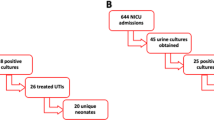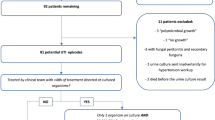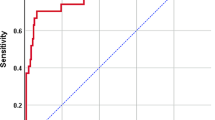Abstract
Objective:
Urinary tract infections (UTI) are common in the neonatal intensive care unit (NICU). Blood, urine and cerebrospinal fluid (CSF) cultures are frequently obtained to evaluate for infection. We sought to determine the concordance between positive urine cultures and blood or CSF cultures.
Study Design:
Infants <121 days of age with a UTI admitted to 322 NICUs managed by the Pediatrix Medical Group from 1997 to 2010 were identified. UTIs were defined by isolation of a single pathogenic organism in a urine sample obtained by catheterization or suprapubic tap. The UTI was concordant if the same organism was identified in the blood or CSF within 3 days of the urine culture.
Result:
Of 5681 infants with a urine culture, 984 had 1162 UTIs. In total, 976 UTIs (84%) had a blood culture collected within 3 days, and 127 (13%) were concordant. Of the 1162 UTIs, 77 (7%) had a CSF culture collected within 3 days, and 2 (3%) were concordant.
Conclusion:
Collection of a urine culture in infants evaluated for late-onset sepsis is important. Concordance was observed in 13% of blood cultures and 3% of CSF cultures. These findings may be related to the initiation of empirical antimicrobial therapy before evaluation for disseminated infection or poor blood culture sensitivity.
This is a preview of subscription content, access via your institution
Access options
Subscribe to this journal
Receive 12 print issues and online access
$259.00 per year
only $21.58 per issue
Buy this article
- Purchase on Springer Link
- Instant access to full article PDF
Prices may be subject to local taxes which are calculated during checkout
Similar content being viewed by others
References
Bauer S, Eliakim A, Pomeranz A, Regev R, Litmanovits I, Arnon S et al. Urinary tract infection in very low birth weight preterm infants. Pediatr Infect Dis J 2003; 22: 426–430.
Eliakim A, Dolfin T, Korzets Z, Wolach B, Pomeranz A . Urinary tract infection in premature infants: the role of imaging studies and prophylactic therapy. J Perinatol 1997; 17: 305–308.
Tamim MM, Alesseh H, Aziz H . Analysis of the efficacy of urine culture as part of sepsis evaluation in the premature infant. Pediatr Infect Dis J 2003; 22: 805–808.
Levy I, Comarsca J, Davidovits M, Klinger G, Sirota L, Linder N . Urinary tract infection in preterm infants: the protective role of breastfeeding. Pediatr Nephrol 2009; 24: 527–531.
Phillips JR, Karlowicz MG . Prevalence of Candida species in hospital-acquired urinary tract infections in a neonatal intensive care unit. Pediatr Infect Dis J 1997; 16: 190–194.
Stoll BJ, Hansen N, Fanaroff AA, Wright LL, Carlo WA, Ehrenkranz RA et al. To tap or not to tap: high likelihood of meningitis without sepsis among very low birth weight infants. Pediatrics 2004; 113: 1181–1186.
Crain EF, Gershel JC . Urinary tract infections in febrile infants younger than 8 weeks of age. Pediatrics 1990; 86: 363–367.
Practice parameter: the diagnosis, treatment, and evaluation of the initial urinary tract infection in febrile infants and young children. American Academy of Pediatrics. Committee on Quality Improvement. Subcommittee on Urinary Tract Infection. Pediatrics 1999; 103 (4 Part 1): 843–852.
Mehta G, Singh S, Kumari S . Observations on coagulase-negative staphylococci in a neonatal unit in India. J Hosp Infect 1991; 19: 273–281.
D'Angio CT, McGowan KL, Baumgart S, Geme J, Harris MC . Surface colonization with coagulase-negative staphylococci in premature neonates. J Pediatr 1989; 114: 1029–1034.
Jiang JH, Chiu NC, Huang FY, Kao HA, Hsu CH, Hung HY et al. Neonatal sepsis in the neonatal intensive care unit: characteristics of early versus late onset. J Microbiol Immunol Infect 2004; 37: 301–306.
Perlman SE, Saiman L, Larson EL . Risk factors for late-onset health care-associated bloodstream infections in patients in neonatal intensive care units. Am J Infect Control 2007; 35: 177–182.
Feja KN, Wu F, Roberts K, Loughrey M, Nesin M, Larson E et al. Risk factors for candidemia in critically ill infants: a matched case-control study. J Pediatr 2005; 147: 156–161.
Stoll BJ, Hansen N, Fanaroff AA, Wright LL, Carlo WA, Ehrenkranz RA et al. Late-onset sepsis in very low birth weight neonates: the experience of the NICHD Neonatal Research Network. Pediatrics 2002; 110 (2 Pt 1): 285–291.
Karlowicz MG, Buescher ES, Surka AE . Fulminant late-onset sepsis in a neonatal intensive care unit, 1988-1997, and the impact of avoiding empiric vancomycin therapy. Pediatrics 2000; 106: 1387–1390.
Benjamin DK, DeLong E, Cotten CM, Garges HP, Steinbach WJ, Clark RH . Mortality following blood culture in premature infants: increased with gram-negative bacteremia and candidemia, but not gram-positive bacteremia. J Perinatol 2004; 24: 175–180.
Ginsburg CM, McCracken GH . Urinary tract infections in young infants. Pediatrics 1982; 69: 409–412.
Honkinen O, Jahnukainen T, Mertsola J, Eskola J, Ruuskanen O . Bacteremic urinary tract infection in children. Pediatr Infect Dis J 2000; 19: 630–634.
Jakobsson B, Esbjorner E, Hansson S . Minimum incidence and diagnostic rate of first urinary tract infection. Pediatrics 1999; 104 (2 Part 1): 222–226.
Shah SS, Zorc JJ, Levine DA, Platt SL, Kuppermann N . Sterile cerebrospinal fluid pleocytosis in young infants with urinary tract infections. J Pediatr 2008; 153: 290–292.
Garges HP, Moody MA, Cotten CM, Smith PB, Tiffany KF, Lenfestey R et al. Neonatal meningitis: what is the correlation among cerebrospinal fluid cultures, blood cultures, and cerebrospinal fluid parameters? Pediatrics 2006; 117: 1094–1100.
Acknowledgements
This study used CTSA biostatistical services through the Division of Pediatric Quantitative Sciences (NIH-5UL-1RR024128-01).
Author information
Authors and Affiliations
Corresponding author
Ethics declarations
Competing interests
Dr Benjamin receives support from the United States government for his work in pediatric and neonatal clinical pharmacology (1R01HD057956-02, 1R01FD003519-01, 1U10-HD45962-06, 1K24HD058735-01 and Government contract HHSN267200700051C), from the non-profit organization Thrasher Research Foundation for his work in neonatal candidiasis (http://www.thrasherresearch.org) and from the industry for neonatal and pediatric drug development (http://www.dcri.duke.edu/research/coi.jsp). Dr Smith received support from the NICHD 1K23HD060040-01 and DHHS-1R18AE000028-01. Dr Downey received support from the T-32 Multidisciplinary Neonatal Training Grant (2T32 HD043728-06, PI Goldberg). Dr Watt received support from a T-32 Multidisciplinary Pediatric Training Grant (5T32HD043029-09, PI St Geme). Dr Cohen-Wolkowiez received support from the United States government for his work in pediatric and neonatal clinical pharmacology (Government contract HHSN267200700051C, PI Benjamin) and from the NICHD (1K23HD064814-01). No sponsoring agency had a role in the study design; collection, analysis and interpretation of the data; writing of the report; or the decision to submit the manuscript for publication. The remaining authors declare no conflict of interest.
Rights and permissions
About this article
Cite this article
Downey, L., Benjamin, D., Clark, R. et al. Urinary tract infection concordance with positive blood and cerebrospinal fluid cultures in the neonatal intensive care unit. J Perinatol 33, 302–306 (2013). https://doi.org/10.1038/jp.2012.111
Received:
Revised:
Accepted:
Published:
Issue Date:
DOI: https://doi.org/10.1038/jp.2012.111
Keywords
This article is cited by
-
Incidence and risk factors of urinary tract infection in neonatal sepsis
Beni-Suef University Journal of Basic and Applied Sciences (2022)
-
Late-onset sepsis due to urinary tract infection in very preterm neonates is not uncommon
European Journal of Pediatrics (2018)



